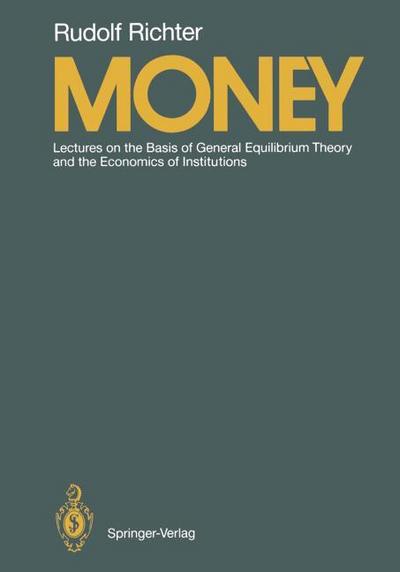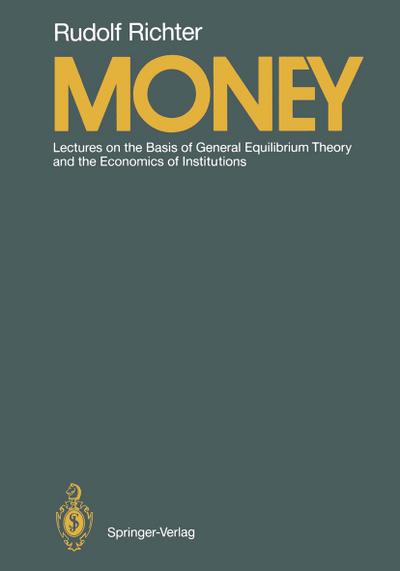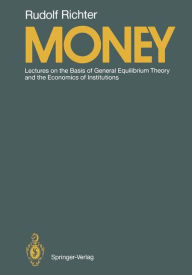
Money : Lectures on the Basis of General Equilibrium Theory and the Economics of Institutions - Livres de poche
2011, ISBN: 3642740391
[EAN: 9783642740398], Neubuch, [SC: 36.16], [PU: Springer Berlin Heidelberg], ECONOMICTHEORY; INSTITUTIONALECONOMICS; MICROECONOMICS; MONETARYPOLICY; DEREGULATION, Druck auf Anfrage Neuwa… Plus…
| ZVAB.com AHA-BUCH GmbH, Einbeck, Germany [51283250] [Rating: 5 (von 5)] NEW BOOK. Frais d'envoi EUR 36.16 Details... |

Money : Lectures on the Basis of General Equilibrium Theory and the Economics of Institutions - Livres de poche
2011, ISBN: 3642740391
[EAN: 9783642740398], Neubuch, [PU: Springer Berlin Heidelberg], ECONOMICTHEORY; INSTITUTIONALECONOMICS; MICROECONOMICS; MONETARYPOLICY; DEREGULATION, Druck auf Anfrage Neuware - Printed … Plus…
| AbeBooks.de AHA-BUCH GmbH, Einbeck, Germany [51283250] [Rating: 5 (von 5)] NEW BOOK. Frais d'envoiVersandkostenfrei. (EUR 0.00) Details... |

2011, ISBN: 3642740391
[EAN: 9783642740398], Neubuch, [PU: Springer Berlin Heidelberg Dez 2011], ECONOMICTHEORY; INSTITUTIONALECONOMICS; MICROECONOMICS; MONETARYPOLICY; DEREGULATION, This item is printed on dem… Plus…
| AbeBooks.de BuchWeltWeit Ludwig Meier e.K., Bergisch Gladbach, Germany [57449362] [Rating: 5 (von 5)] NEW BOOK. Frais d'envoiVersandkostenfrei. (EUR 0.00) Details... |

ISBN: 9783642740398
The central idea of this book is the concept of a currency order. Monetary theory is developed as a theory of currency orders. The book expands the neoclassical theory of currency orders.… Plus…
| BarnesandNoble.com new in stock. Frais d'envoizzgl. Versandkosten., Livraison non-comprise Details... |

ISBN: 9783642740398
The central idea of this book is the concept of a currency order. Monetary theory is developed as a theory of currency orders. The book expands the neoclassical theory of currency orders.… Plus…
| Springer.com Nr. 978-3-642-74039-8. Frais d'envoiWorldwide free shipping, , zzgl. Versandkosten. (EUR 0.00) Details... |


Money : Lectures on the Basis of General Equilibrium Theory and the Economics of Institutions - Livres de poche
2011, ISBN: 3642740391
[EAN: 9783642740398], Neubuch, [SC: 36.16], [PU: Springer Berlin Heidelberg], ECONOMICTHEORY; INSTITUTIONALECONOMICS; MICROECONOMICS; MONETARYPOLICY; DEREGULATION, Druck auf Anfrage Neuwa… Plus…

Rudolf Richter:
Money : Lectures on the Basis of General Equilibrium Theory and the Economics of Institutions - Livres de poche2011, ISBN: 3642740391
[EAN: 9783642740398], Neubuch, [PU: Springer Berlin Heidelberg], ECONOMICTHEORY; INSTITUTIONALECONOMICS; MICROECONOMICS; MONETARYPOLICY; DEREGULATION, Druck auf Anfrage Neuware - Printed … Plus…

2011
ISBN: 3642740391
[EAN: 9783642740398], Neubuch, [PU: Springer Berlin Heidelberg Dez 2011], ECONOMICTHEORY; INSTITUTIONALECONOMICS; MICROECONOMICS; MONETARYPOLICY; DEREGULATION, This item is printed on dem… Plus…

ISBN: 9783642740398
The central idea of this book is the concept of a currency order. Monetary theory is developed as a theory of currency orders. The book expands the neoclassical theory of currency orders.… Plus…
ISBN: 9783642740398
The central idea of this book is the concept of a currency order. Monetary theory is developed as a theory of currency orders. The book expands the neoclassical theory of currency orders.… Plus…
Données bibliographiques du meilleur livre correspondant
| Auteur: | |
| Titre: | |
| ISBN: |
Informations détaillées sur le livre - Money: Lectures on the Basis of General Equilibrium Theory and the Economics of Institutions Rudolf Richter Author
EAN (ISBN-13): 9783642740398
ISBN (ISBN-10): 3642740391
Version reliée
Livre de poche
Date de parution: 2011
Editeur: Springer Berlin Heidelberg Core >1
Livre dans la base de données depuis 2012-08-30T15:12:35+02:00 (Paris)
Page de détail modifiée en dernier sur 2023-11-25T15:27:12+01:00 (Paris)
ISBN/EAN: 9783642740398
ISBN - Autres types d'écriture:
3-642-74039-1, 978-3-642-74039-8
Autres types d'écriture et termes associés:
Auteur du livre: richter rudolf, rudolf just, stolper, will richter, wolfgang
Titre du livre: basis theory, general economics, money and its uses, where does money comes from, where does money come from, lectures, institutions economics
Données de l'éditeur
Auteur: Rudolf Richter
Titre: Money - Lectures on the Basis of General Equilibrium Theory and the Economics of Institutions
Editeur: Springer; Springer Berlin
399 Pages
Date de parution: 2011-12-10
Berlin; Heidelberg; DE
Imprimé / Fabriqué en
Traducteur: Wolfgang F. Stolper
Poids: 0,721 kg
Langue: Anglais
53,49 € (DE)
54,99 € (AT)
59,00 CHF (CH)
POD
XVI, 399 p.
BC; Economics, general; Hardcover, Softcover / Wirtschaft/Volkswirtschaft; Wirtschaftswissenschaft; Verstehen; deregulation; economic theory; institutional economics; institutions; microeconomics; monetary policy; Economics; BB
I. Theoretical Foundations: An Elementary Overview.- 1. General Equilibrium Theory: An Outline.- 1.1 General Equilibrium Theory Without Production.- 1.2 General Equilibrium Theory With Production.- 1.3 The Purchasing Power of Money: Definition.- 1.4 The Determination of the Purchasing Power of Money.- 1.4.1 The Case of a Commodity Standard: The Pure Gold Coin Standard.- 1.4.2 The Case of a Paper Standard: A Pure Paper Circulation.- 1.5 The Classical Dichotomy and the Patinkin Controversy.- Appendix to Chapter 1.- 1. The Determination of the Optimal Consumption Plan of a Household.- 2. The Determination of the Optimal Production Plan of a Firm.- 3. Walras’s Law With Any Number of Households and Firms.- Suggested Readings to Chapter 1.- 1. Theory of General Equilibrium.- 2. The Purchasing Power of Money.- 3. Determination of the Purchasing Power of Money.- 2. Capital Theory.- 2.1 The General Approach.- 2.2 A Simple Robinson Economy.- 2.3 Two Present and Two Future Goods: Does “the” Real Rate of Interest Exist?.- 2.4 The Robinson Economy in Stationary Equilibrium.- 2.5 The Young and the Old Robinsons: The Stationary Theory of Overlapping Generations.- 2.5.1 An Overlapping Generations Model Without Production.- 2.5.2 An Overlapping Generations Model With Production.- Appendix to Chapter 2.- The Stationary Rate of Interest May be Different from Zero.- Suggested Readings to Chapter 2.- 1. The Robinson Economy.- 2. The General Case.- 3. The Optimal Capital Stock of an Economy.- 4. Two Approaches to Capital Theory.- 5. General Discussion of Capital and Interest Theory.- 6. The Model of Overlapping Generations.- 3. The Economics of Institutions.- 3.1 Topics of Modern Institutional Economics.- 3.2 What are Transaction Costs?.- 3.3 Transaction Costs in General Equilibrium Theory: A Simple Example.- 3.4 Why Economic Institutions?.- 3.4.1 The Market as an Institution: Auction Markets or Direct Negotiations?.- 3.4.2 Why Do Firms Exist?.- 3.4.3 Why Relational Contracts?.- 3.4.4 Why Public Regulation?.- 3.5 General Equilibrium and Institutional Economics: Some Conceptual Considerations.- Appendix to Chapter 3.- Utility Maximization of the Household Including Transaction Costs.- Suggested Readings to Chapter 3.- 1. Property Rights and Transaction Costs in General.- 2. Transaction Costs in General Equilibrium Theory.- 3. Why Economic Institutions?.- a) Auction Markets or Direct Negotiations?.- b) Why Do Firms Exist?.- c) Why Relational Contracts?.- d) Internalization of External Effects.- e) Why Public Regulation?.- 4. On the Economic Theory of Institutions.- II. Monetary Theory.- 4. The Nature of Money.- 4.1 The Elementary Currency Order: Some Basic Considerations.- 4.2 Further Discussion of the Elementary Currency Order.- 4.2.1 The Bookkeeping Order.- 4.2.2 The Order of Safeguarding the Value of Money.- 4.3 Economic Explanation of an Elementary Currency Order: The Bookkeeping Order.- 4.3.1 An Illustration of the Advantages of a General Unit of Account.- 4.3.2 An Illustration of the Advantages of General Means of Exchange as a Means of Payment.- 4.4 Economic Explanation of the Elementary Currency Order: The Value Safeguarding Order.- 4.5 Money Loans.- 4.6 Competition in Currencies.- Appendix to Chapter 4.- The Black-Fama-Hall System.- Suggested Readings to Chapter 4.- 1. The Elementary Currency Order.- 2. The Economic Explanation of the Use of Money.- 3. The Economic Explanation of the Order of Safeguarding the Value of Money.- 4. The Early History of Money.- 5. The Law of Money.- 6. On Currency Competition.- 5. An Abstract Book-Money Economy.- 5.1 A Central Accounting System.- 5.1.1 The Account of the Household Robinson.- 5.1.2 The Account of the Firm Robinson.- 5.2 Money Loan Transactions.- 5.3 The Neo-Classical Theory of the Money or Nominal Rate of Interest: A Simple Case.- 5.4 The Neo-Classical Theory of the Money or Nominal Rate of Interest: Some Extensions.- 5.4.1 Two Present and Two Future Goods.- 5.4.2 One Good and Three Periods.- 5.5 Interest and Prices.- 5.6 The Case of Two Currencies: Some Elementary Arbitrage Calculations.- 5.7 Fixed or Flexible Exchange Rates? Some Elementary Considerations.- 5.7.1 Flexible Exchange Rates.- 5.7.2 Fixed Exchange Rates.- 5.8 Neutral Money.- Suggested Readings to Chapter 5.- 1. A Pure Book-Money System.- 2. The Neoclassical Theory of the Nominal Rate of Interest.- 3. The Theory of Commodity Futures Markets.- 4. The Term Structure of Interest Rates.- 5. Wicksell’s Theory on the Spread Between Real and Nominal Interest Rates.- 6. The Purchasing-Power-Parity Theory (PPP).- 7. The Theory of Forward Exchange.- 8. Fixed versus Flexible Exchange Rates.- 9. Neutral Money.- 6. The Quantity of Money and the Prices of Goods.- 6.1 A World With Transaction Costs.- 6.2 Optimal Cash Balances.- 6.3 Cash Balances in General Equilibrium: A Monetary Overlapping Generations Model.- 6.4 An Illustration of the Monetary Overlapping Generations Model.- 6.5 A Simple Stationary Equilibrium With Rational Expectations.- 6.6 Neutrality of Money With Cash Balances.- Appendix to Chapter 6.- 1. The Dimension of the Marginal Costs of Transaction.- 2. The Optimal Consumption and Investment Plan of the Household: An Example.- 3. On the Direct Utility Approach to the Demand for Money and Bonds.- Suggested Readings to Chapter 6.- 1. Temporary Equilibrium.- 2. Optimal Cash Balances.- 3. Once More: The Model of Overlapping Generations.- 4. Rational Expectations.- 5. The Problem of the Non-Neutrality of Money.- 6. The Monetarism Debate.- 7. Safeguarding the Value of Money - Some Basic Institutional Solutions.- 7.1 Safeguarding the Value of Money With a Redeemable Paper Currency: The Case of a Single Currency.- 7.2 Safeguarding the Value of Money With Redeemable Paper Currencies: The Case of Two Currencies.- 7.3 Safeguarding the Value of Money With an Inconvertible Paper Currency: The Case of a Single Currency.- 7.4 Safeguarding the Value of Money With Inconvertible Paper Currencies: Two Currencies.- 7.4.1 The System of Flexible Exchange Rates.- 7.4.2 The System of Fixed Exchange Rates.- 7.5 Gold or Paper? A Retrospective of This Chapter.- Suggested Readings to Chapter 7.- 1. The Gold Standard.- 2. The Paper Standard.- 3. Balance of Payments Theories.- 4. The Problem of the Stability of Flexible Exchange Rates.- 5. Arguments and Proposals for an International Coordination of Exchange Rate Policy.- 6. Gold or Paper?.- 8. Money and Banks.- 8.1 The Theory of the Banking Firm: Preliminary Considerations.- 8.2 The Banking Firm as a Financial Intermediary: A Simple Model.- 8.3 The Demand For Bank Money.- 8.4 The Banking Firm as the Central Agent of a Primary Currency Community: The Commodity Standard.- 8.5 The Banking Firm as the Central Agent of a Primary Currency Community: The Paper Standard.- 8.6 The Banking Firm as the Central Agent of a Secondary Currency Community.- 8.7 Comments on the Public Regulation of Money and Banking.- 8.7.1 Public Regulation of the Central Agents of Primary Currency Communities (Central Banks).- 8.7.2 Public Regulation of the Central Agents of Secondary Currency Communities (Commercial Banks).- Appendix to Chapter 8.- 1. Profit Maximization of the Bank Assuming Cost of Obtaining Reserves (Section 8.2).- 2. Determination of the Optimal Intertemporal Consumption and Investment Plans of the Consumer: The Direct Utility Approach (Section 8.3).- 3. Determination of the Optimal Intertemporal Consumption and Investment Plan of the Consumer: The Transaction Costs Approach (Section 8.3).- Suggested Readings to Chapter 8.- 1. The Theory of the Banking Firm.- 2. The Currency-Banking Debate.- 3. The Real Bills Doctrine.- 4. Maximization of Seigniorage.- 5. The Theory of Credit Creation.- 6. Minimum Reserves.- 7. The New Monetary Economics.- 8. The Rational Justification of a Central Bank: Free Banking or Central Banking?.- 9. The Theory and Practice of Central Bank Constitutions.- 10. Bank Regulation.- Name Index.Autres livres qui pourraient ressembler au livre recherché:
Dernier livre similaire:
9781441935823 The Didactical Challenge of Symbolic Calculators: Turning a Computational Device into a Mathematical Instrument Dominique Guin Editor (Herausgegeben von Guin, Dominique Ruthven, Kenneth Trouche, Luc)
- 9781441935823 The Didactical Challenge of Symbolic Calculators: Turning a Computational Device into a Mathematical Instrument Dominique Guin Editor (Herausgegeben von Guin, Dominique Ruthven, Kenneth Trouche, Luc)
- 9780387502533 The Didactical Challenge of Symbolic Calculators (Richter, Rudolf)
- 9780387231587 The Didactical Challenge of Symbolic Calculators: Turning a Computational Device into a Mathematical Instrument (Mathematics Education Library, 36) (Guin, Dominique)
- Money. Lectures on the Basis of General Equilibrium Theory and t he Economics of Institutions. (Richter, Rudolf)
< pour archiver...

